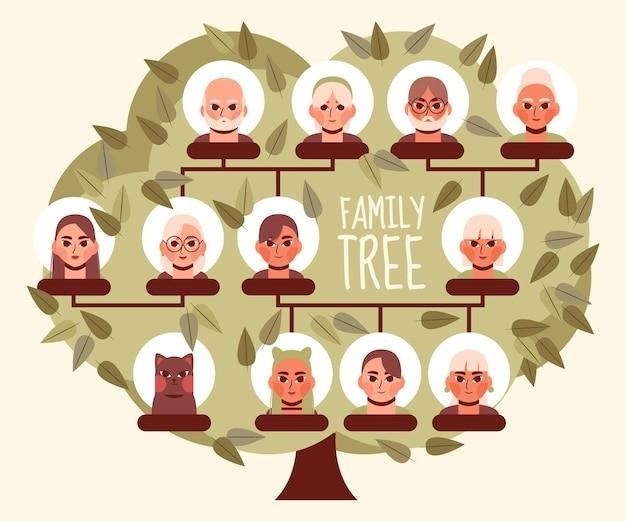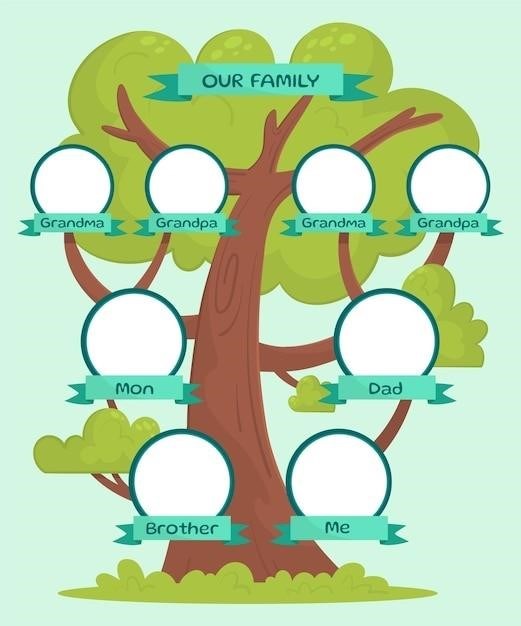Adam and Eve Family Tree⁚ A Biblical Genealogy
The Adam and Eve Family Tree is a central concept in Abrahamic religions, particularly Christianity and Judaism. It traces the lineage of humanity back to the first humans, Adam and Eve, as described in the Book of Genesis. This family tree is crucial for understanding the biblical narrative of creation, the fall of humanity, and the subsequent redemption through Jesus Christ. The Adam and Eve Family Tree Chart is a visual representation of this genealogy, often depicting the key figures and their relationships. It can be a valuable resource for individuals interested in studying the Bible and understanding the historical context of the Christian faith.
The Genesis Narrative
The Genesis narrative provides the foundation for the Adam and Eve family tree. In the Book of Genesis, chapters 1-5, the story of creation, the Garden of Eden, and the fall of humanity unfolds. God creates Adam, the first man, from the dust of the earth and breathes life into him. God then creates Eve, the first woman, from Adam’s rib. They are placed in the Garden of Eden, a paradise where they are free to enjoy God’s presence and abundance, with one restriction⁚ they are not to eat from the Tree of Knowledge of Good and Evil. However, tempted by the serpent, Eve disobeys God’s command and eats from the forbidden fruit, and she convinces Adam to do the same. This act of disobedience, known as the Fall, brings sin into the world, and Adam and Eve are expelled from the Garden of Eden. The narrative continues with the birth of their children. Adam and Eve have three sons mentioned by name⁚ Cain, Abel, and Seth. The story of Cain and Abel is a tale of jealousy and murder, as Cain, envious of his brother’s sacrifice, kills Abel. God punishes Cain for his sin, banishing him from the land. Seth is born as a replacement for Abel, and he becomes the ancestor of the line that continues through the generations. The Genesis narrative lays the groundwork for the Adam and Eve family tree, establishing the origin of humanity, the introduction of sin and death, and the lineage that would eventually lead to the coming of the Messiah.

Cain, Abel, and Seth
The Adam and Eve family tree begins with the birth of their three sons⁚ Cain, Abel, and Seth. Each of these sons plays a significant role in the biblical narrative and in the understanding of human history. Cain, the firstborn, is known for his jealousy and anger. He is a farmer, and when God favors Abel’s offering over his own, Cain becomes enraged and murders his brother. God punishes Cain for his sin, banishing him from the land and marking him with a sign so that no one would harm him. Abel, the second son, is described as a shepherd. He is a righteous man who offers a pleasing sacrifice to God, which contrasts with Cain’s offering. His death at the hands of his brother is a tragic event that introduces the concept of sin and death into the world. Seth, the third son, is born after the death of Abel. He is seen as a replacement for Abel, and God promises that through Seth, a new line of descendants will be born. The story of Cain, Abel, and Seth highlights the themes of sin, jealousy, violence, and the need for redemption. They represent the early stages of human history, a time marked by both goodness and darkness. Their lives, and their choices, set the stage for the development of the human race and its relationship with God.
The Lineage of Seth
The lineage of Seth is crucial in the Adam and Eve family tree because it represents the continuation of the “righteous line” after the sin of Cain. Genesis 5 details the descendants of Seth, starting with his son Enos, who is described as the “first to call on the name of the Lord.” This signifies the beginning of a conscious relationship with God, a contrast to the generations before him. The genealogy continues through generations of individuals who lived remarkably long lives, with the biblical text specifying their ages at death. This longevity serves as a testament to the closeness of these individuals to God, representing a time when humans lived closer to the divine. The lineage of Seth continues through the generations, leading ultimately to Noah, the patriarch who survives the Great Flood, marking a pivotal moment in human history. The descendants of Seth are seen as the chosen line, the ones who carry the promise of God’s covenant with humanity. They are the ancestors of Abraham, the father of the Jewish people, and through him, the lineage continues to Jesus Christ, the central figure in Christian faith. The lineage of Seth, therefore, plays a vital role in connecting the first humans to the central figures of religious tradition, demonstrating the continuity of God’s plan for humanity.
The Importance of Seth’s Descendants
The descendants of Seth hold a significant position within the biblical narrative, particularly in the context of the Adam and Eve family tree. They are presented as the “righteous line,” representing a continuation of God’s covenant with humanity after the sin of Cain. Their lineage is seen as a testament to God’s faithfulness and his ongoing commitment to his creation. The importance of Seth’s descendants lies in their connection to the key figures of biblical history, including Noah, Abraham, and ultimately, Jesus Christ. Through Seth’s line, the promise of redemption is carried forward, demonstrating the enduring nature of God’s plan for humanity. Their long lifespans, as recorded in Genesis, symbolize a close relationship with God, highlighting a period when humanity lived closer to the divine. The descendants of Seth are not merely historical figures but represent a spiritual lineage, a thread connecting the first humans to the central figures of religious faith. Their importance lies in their role as the carriers of God’s covenant, the ones who maintain the connection between humanity and the divine, ensuring that the promise of redemption remains alive throughout history.
The Role of Adam and Eve in Theology
Adam and Eve, as the first humans in the biblical narrative, play a pivotal role in theological discourse. Their story, as recounted in Genesis, is foundational to understanding concepts of sin, redemption, and humanity’s relationship with God. Their creation, representing the pinnacle of God’s creative act, signifies the inherent goodness and potential of humanity. However, their transgression, the “fall” from grace, introduces the concept of sin and its consequences, including death and separation from God. This event, often interpreted as a symbolic representation of humanity’s susceptibility to temptation and its subsequent alienation from God, is central to Christian theology. The Adam and Eve story underscores the need for redemption, which is ultimately achieved through the sacrifice of Jesus Christ, who is seen as the second Adam, offering a way back to God’s grace. Their role in theology extends beyond the narrative itself, serving as a metaphorical framework for understanding the human condition, the nature of sin, and the necessity of redemption. Adam and Eve, through their story, shape the theological landscape, providing a foundation for understanding the human experience and its relationship with the divine.
The Adam and Eve Family Tree Chart
The Adam and Eve Family Tree Chart is a visual representation of the biblical genealogy tracing the lineage of humanity back to Adam and Eve. These charts typically depict the key figures, their relationships, and sometimes even their lifespan and significant events in their lives. They can be found in various formats, from simple hand-drawn diagrams to elaborate, digitally generated charts with detailed information. The Adam and Eve Family Tree Chart serves several purposes. It provides a visual aid for understanding the biblical narrative of creation and the interconnectedness of individuals within the biblical story. It can also be a tool for studying biblical history and tracing the lineage of key figures like Noah, Abraham, and ultimately, Jesus Christ. These charts are often used in religious education, family history research, and personal spiritual exploration. The Adam and Eve Family Tree Chart, in its various forms, offers a tangible representation of a foundational biblical concept, making it a valuable resource for understanding the biblical narrative and its theological implications.
The Adam and Eve Family Tree Software
The Adam and Eve Family Tree Software is a digital tool designed to help individuals explore and visualize the biblical genealogy of Adam and Eve. These software programs typically offer a user-friendly interface that allows users to create, edit, and customize their own family tree charts. The software may include features such as⁚
- A database of biblical figures with their relationships and key events in their lives.
- Templates for creating different types of family tree charts, including traditional tree structures, fan charts, and pedigree charts.
- Customization options for fonts, colors, and layout to create visually appealing and informative charts.
- The ability to export charts in various formats, such as PDF, JPEG, and PNG, for printing or sharing.
The Adam and Eve Family Tree Software provides a convenient and interactive way to explore the biblical narrative and understand the lineage of humanity. It can be a valuable tool for individuals interested in studying the Bible, tracing their own family history, or simply exploring the fascinating world of genealogy.
The Adam and Eve Family Tree in Popular Culture
The story of Adam and Eve and their family tree has had a significant impact on popular culture, appearing in various forms of media, from literature and film to music and art. The narrative of the first humans, their fall from grace, and the consequences of their actions resonates with audiences across generations.
- In literature, the Adam and Eve story is often explored in novels, poems, and plays, providing interpretations and reinterpretations of the biblical narrative. Works like Milton’s “Paradise Lost” and Atwood’s “The Handmaid’s Tale” offer unique perspectives on the themes of temptation, free will, and the consequences of human actions.
- In film, the Adam and Eve story has been adapted into countless movies, ranging from biblical epics to comedies. From the classic “The Ten Commandments” to more recent interpretations like “The Tree of Life,” filmmakers have explored the themes of creation, sin, and redemption through the lens of the Adam and Eve narrative.
- Music has also been inspired by the Adam and Eve story, with songs and albums referencing the themes of temptation, paradise, and the fall of man.
The enduring popularity of the Adam and Eve story in popular culture reflects its enduring power and relevance to human experiences, particularly in the exploration of themes of morality, responsibility, and the search for meaning in life.
The Historical and Scientific Context
The concept of a single, universal family tree, originating from Adam and Eve, presents a stark contrast to modern scientific understanding of human evolution. While the biblical narrative posits a literal, historical creation event, scientific evidence points to a much more complex and gradual process of human evolution over millions of years.
- The fossil record and genetic analysis indicate that humans evolved from a common ancestor with other primates, with the emergence of Homo sapiens occurring around 300,000 years ago.
- Genetic studies have traced human ancestry back to Africa, suggesting that modern humans originated there and spread to other parts of the world.
- The concept of a single “Adam” and “Eve” is often interpreted metaphorically within scientific contexts, representing the common ancestors of all modern humans.
The historical and scientific context highlights the distinct perspectives on human origins presented by biblical tradition and modern science. While the Adam and Eve narrative holds a significant place in religious belief, scientific understanding offers a different framework for comprehending the evolutionary journey of humanity.
The Evolution of Human Ancestry
The scientific understanding of human ancestry paints a picture vastly different from the biblical narrative of Adam and Eve. Evolutionary science, supported by a wealth of fossil evidence and genetic analysis, suggests that humans evolved from a long line of primate ancestors over millions of years. This evolutionary journey is characterized by gradual changes, with various hominin species emerging and eventually becoming extinct, leading to the emergence of Homo sapiens.
- Fossil discoveries have revealed a diverse array of hominin species, including Australopithecus, Homo habilis, and Homo erectus, providing insights into the gradual development of human traits like bipedalism, tool use, and increased brain size.
- Genetic studies have further illuminated the evolutionary relationships between different human populations, tracing their ancestry back to a common ancestor in Africa. These studies indicate a complex history of migrations, interbreeding, and adaptation, leading to the diverse genetic makeup of modern humans.
The evolution of human ancestry is a continuous process, with ongoing research shedding further light on the complex tapestry of our evolutionary past. This scientific understanding challenges the literal interpretation of the Adam and Eve narrative but offers a compelling and evidence-based explanation of human origins.
The Relationship Between Genetics and Biblical Genealogy
The field of genetics has provided a powerful tool for understanding human ancestry, but it also raises intriguing questions about the relationship between genetic data and the biblical narrative of Adam and Eve. While genetics can trace lineage through shared DNA patterns, it often conflicts with the literal interpretation of the biblical family tree.
- Genetic studies have identified a “mitochondrial Eve” and a “Y-chromosomal Adam,” representing the most recent common ancestors for all humans based on mitochondrial DNA and Y-chromosome lineages. These figures are not literal individuals but represent the points in time when these specific lineages diverged.
- The concept of a single, historical Adam and Eve who were the sole ancestors of all humanity is challenged by the diversity of human genetic lineages and the evidence of interbreeding between different hominin species.
The relationship between genetics and biblical genealogy is a complex one, often leading to debates between scientific and religious perspectives. While genetics provides a powerful tool for understanding human ancestry, its findings often conflict with the literal interpretation of the biblical narrative.
The Significance of the Adam and Eve Family Tree
The Adam and Eve family tree holds profound significance in both religious and cultural contexts. It serves as a cornerstone of Abrahamic faiths, particularly Christianity and Judaism, providing a foundation for their understanding of human origins, sin, and redemption.
- The biblical narrative of Adam and Eve’s creation, fall, and expulsion from the Garden of Eden is central to the concept of original sin, a doctrine that emphasizes the inherent fallen nature of humanity. This narrative explains the presence of suffering, death, and evil in the world.
- The Adam and Eve family tree also highlights the importance of lineage and ancestry in shaping individual identities and cultural traditions. It provides a framework for understanding family relationships, social structures, and the transmission of knowledge and values across generations.
- Furthermore, the Adam and Eve family tree serves as a symbol of unity and shared humanity. The belief that all individuals are descended from a single pair of ancestors promotes a sense of interconnectedness and shared responsibility.
In conclusion, the Adam and Eve family tree plays a vital role in shaping religious beliefs, cultural narratives, and individual perspectives on human origins and destiny. Its influence extends far beyond the realm of literal interpretation, prompting reflection on themes of sin, redemption, family, and the interconnectedness of all humanity.
The Adam and Eve family tree, a cornerstone of Abrahamic religions, remains a subject of both fascination and debate. While its literal interpretation has been challenged by scientific advancements, its symbolic significance continues to resonate with believers and non-believers alike.
- The family tree serves as a powerful narrative that speaks to the shared origins and interconnectedness of humanity. It emphasizes the enduring themes of sin, redemption, and the search for meaning in a complex world.
- Furthermore, the Adam and Eve family tree provides a framework for understanding the development of human culture, traditions, and beliefs. Its exploration prompts reflection on the nature of faith, the role of ancestry, and the enduring quest for knowledge and understanding.
- While its historical accuracy may be debated, the Adam and Eve family tree remains a potent symbol of hope and possibility, reminding us that even amidst imperfection and struggle, humanity possesses the capacity for growth, transformation, and the pursuit of a higher purpose.
In conclusion, the Adam and Eve family tree, despite its complex and sometimes controversial nature, continues to inspire and challenge us to consider the profound questions about our origins, our purpose, and our place in the vast tapestry of human existence.

